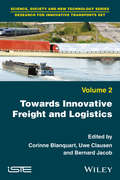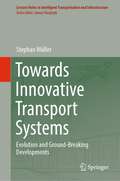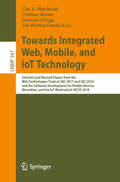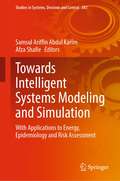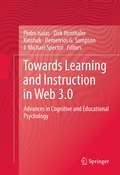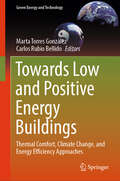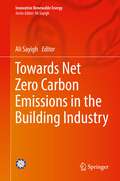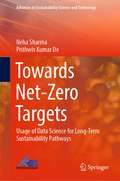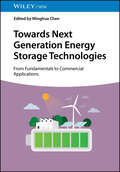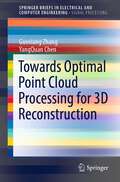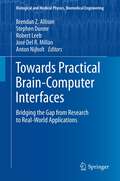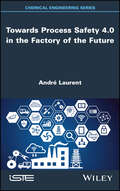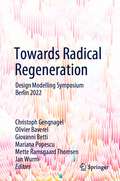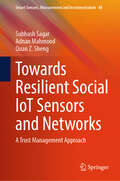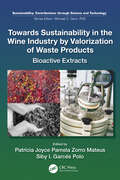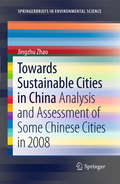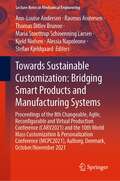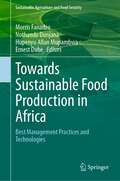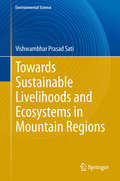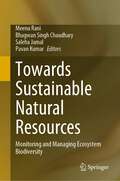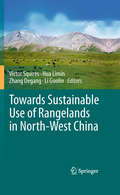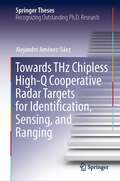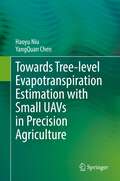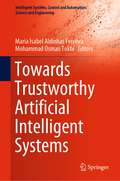- Table View
- List View
Towards Innovative Freight and Logistics
by Bernard Jacob Uwe Clausen Corinne BlanquartFreight transport faces a dual challenge: it must satisfy the demands of globalized trade and meet environmental requirements. In this context, innovation is a crucial topic to enable the transition from the current transportation and logistics system to a sustainable system. This book provides an overview of the latest technological innovations in Europe and worldwide, based on ICT and new vehicle concepts, for all modes and all scales (urban, regional, national or international). The authors consider innovation supply, the process of innovation and innovative business models. Some perspectives and solutions are proposed on the deployment of innovation, specifically concerning the transformation of the organization of the system and the relationships between industry, governmental players, operators and users.
Towards Innovative Transport Systems: Evolution and Ground-Breaking Developments (Lecture Notes in Intelligent Transportation and Infrastructure)
by Stephan MüllerThis book supports companies in the transport sector, political decision-makers, transport engineers, planners and scientists doing fundamental research who are confronted by growing challenges in transport. These challenges arise from a number of powerful socio-technical trends, including: digitalisation, globalisation, urbanisation, and the requirements of individual users and the increased need to reduce environmental impact of transport. Providing the innovations required to cope with these challenges is not a simple matter.Towards Innovative Transport Systems structures and compiles theoretical foundations from evolutionary economics, the sociology of technology and innovation research in a way that provides a broad understanding of innovation processes without demanding prior knowledge. Using the Concept of Transport System Evolution (CTSE), it explains in depth the economics of innovation in the transport sector, thus contextualising processes, drivers and obstacles at work in current practice; among such processes are the changeover to electric mobility, the realization of autonomous cars, the revival of railway by innovations and dealing with disruptive innovations in transport. The CTSE is an approach to making concrete the multi-level perspective for the transport sector introduced by Frank Geels. On the basis of the CTSE, the author proposes principles for a novel innovation policy in transport that can serve the reader as a guide when making strategic decisions.
Towards Integrated Web, Mobile, and IoT Technology: Selected and Revised Papers from the Web Technologies Track at SAC 2017 and SAC 2018, and the Software Development for Mobile Devices, Wearables, and the IoT Minitrack at HICSS 2018 (Lecture Notes in Business Information Processing #347)
by Francesco Poggi Tim A. Majchrzak Cristian Mateos Tor-Morten GrønliThis book deals with integrated Web, mobile, and IoT technologies. Novel approaches and techniques, new tools and frameworks are needed to address the increasing complexity of the distributed computing paradigms that are coming and the applications therein.This volume contains selected and extended papers from a) the Web Technologies track at the 33rd ACM/SIGAPP Symposium On Applied Computing, b) the Web Technologies track at the 32nd ACM/SIGAPP Symposium On Applied Computing, and c) the Software Development for Mobile Devices, Wearables, and the Internet-of-Things Minitrack at the 51st Hawaii International Conference on System Sciences. Overall, it provides a uniform view of cutting-edge research in Web, mobile and IoT technologies.
Towards Integrating Control and Information Theories
by Jie Chen Song Fang Hideaki IshiiThis book investigates the performance limitation issues in networked feedback systems. The fact that networked feedback systems consist of control and communication devices and systems calls for the integration of control theory and information theory. The primary contributions of this book lie in two aspects: the newly-proposed information-theoretic measures and the newly-discovered control performance limitations. We first propose a number of information notions to facilitate the analysis. Using those notions, classes of performance limitations of networked feedback systems, as well as state estimation systems, are then investigated. In general, the book presents a unique, cohesive treatment of performance limitation issues of networked feedback systems via an information-theoretic approach. This book is believed to be the first to treat the aforementioned subjects systematically and in a unified manner, offering a unique perspective differing from existing books.
Towards Intelligent Systems Modeling and Simulation: With Applications to Energy, Epidemiology and Risk Assessment (Studies in Systems, Decision and Control #383)
by Samsul Ariffin Abdul Karim Afza ShafieThis book creates the emergence of disruptive technologies that have led to a significant change in the role of mathematics and statistics for problem solving, with the use of sophisticated software and hardware in solving complex systems and process. In the era of digital technology, mathematics and statistics need to be highly relevant to be able to cater for the needs of IR4.0 such as big data analytics, simulation, autonomous system, and cloud computing. Motivated by this development, a total of 26 chapters are contributed by respectable experts for this book. The main scope of the book is to conduct a new system of modeling and simulations on solving differential equations, nonlinear equations, energy, epidemiology, and risk assessment. This book is of interest for postgraduate students, researchers as well as other scientists who are working in numerical modeling and simulations based on efficient mathematical and statistical techniques.
Towards Learning and Instruction in Web 3.0: Advances in Cognitive and Educational Psychology
by Dirk Ifenthaler J. Michael Spector Kinshuk Pedro Isaias Demetrios G. SampsonTowards Learning and instruction in Web 3.0, which includes selected expanded papers from CELDA (Cognition and Exploratory Learning in the Digital Age) 2010 (http://www.celda-conf.org/) addresses the main issues concerned with evolving learning processes, innovative pedagogies, and technology-based educational applications in the digital age. The convergence of these two disciplines continues to increase and in turn, affects the academic and professional spheres in numerous ways. Towards Learning and Instruction in Web 3.0 addresses paradigms such as just-in-time learning, constructivism, student-centered learning and collaborative approaches which have emerged and are being supported by technological advancements such as simulations,virtual reality and multi-agents systems. This volume touches on both technological as well as psychological and pedagogical issues related to the developments of Web 3.0.
Towards Low and Positive Energy Buildings: Thermal Comfort, Climate Change, and Energy Efficiency Approaches (Green Energy and Technology)
by Marta Torres González Carlos Rubio BellidoThis book evaluates the impact of climate conditions on adaptive strategies, diagnoses prosumers' energy patterns in Positive Energy Buildings, and assesses the social and global dimensions of energy poverty. Addressing the pressing challenges of energy efficiency and climate change adaptation, the book investigates the intricate realm of low and positive energy buildings, demonstrating innovative approaches essential for an environmentally inclusive society. With a focus on thermal comfort, climate change effects, and energy efficiency, the chapters present a diverse array of studies from tropical and Mediterranean climates to worldwide practical cases. By merging dynamic and adaptive energy measures, this book pioneers an holistic approach, crucial for policymakers, stakeholders, academics, and researchers in propelling the transition toward sustainable energy solutions.
Towards Net Zero Carbon Emissions in the Building Industry (Innovative Renewable Energy)
by Ali SayighTowards Net Zero in the Building Industry looks at the contributions that the building and construction industry can (and must) make to help achieve net zero carbon emissions. The building industry accounts for close to 40% of global emissions and this book brings together a global group of contributors from 15 countries to examine ways in which the industry can help with overall CO2 reduction. Coverage includes factors such as building design strategy, materials selection, use of local materials with a low carbon imprint, renewable energy use, energy conservation, greenery and appropriate aesthetics, building size and scale, climate suitability, building functionality and comfort, material recycling, and adoption of green policies. Chapter 6 is available open access under a Creative Commons Attribution 4.0 International License via link.springer.com.
Towards Net-Zero Targets: Usage of Data Science for Long-Term Sustainability Pathways (Advances in Sustainability Science and Technology)
by Neha Sharma Prithwis Kumar DeThis book discusses the use of technology, data science and open data to achieve the net-zero carbon emissions target set up by the Paris Agreement on climate change. There have been many discussions around sustainability and climate change solutions to mitigate the negative impact. However, using technology levers to tackle climate challenges is rarely seen as the most significant catalyst. The available research in this field is generally qualitative in nature, where technology and data have not yet been leveraged. By using AI/ML, the book predicts the climate change consequences arising due to investment in fossil fuel sectors, estimates CO2 emissions from the transport sector, forecasts average land temperature due to non-renewable sources of energy, and segments Indian states on the basis of household carbon emissions. The researchers, policymakers, students, teachers, educational institutions, governments, regulators, companies, international organizations, etc., will benefit immensely by referring to this book. Moreover, the endeavour of this book is to provide a decarbonized environment and a better tomorrow to the next generation.
Towards Next Generation Energy Storage Technologies: From Fundamentals to Commercial Applications
by Minghua ChenDevelop the clean technologies of the future with these novel energy storage technologies Energy storage is a crucial component of the broader battle to develop clean energy sources and transform the power grid in light of advancing climate change. Numerous new energy storage technologies based on electrochemical redox reactions have recently been developed or proposed, promising to reduce costs and enable energy-dense devices and applications of many kinds. This urgent work demands to be incorporated into chemistry, materials science, and industry at every level. Towards Next Generation Energy Storage Technologies offers a comprehensive overview of these novel technologies and their applications. Beginning with an introduction to the fundamentals of electrochemistry and energy storage, it offers current and future research questions, design strategies, and much more. It is a must-own for scientists and engineers looking to develop the energy grid of the future. Towards Next Generation Energy Storage Technologies readers will also find: Summaries of state-of-the-art research and open challengesDetailed discussion of technologies including lithium-ion batteries, all-solid-state batteries, aqueous multi-valence energy storage systems, and moreDiscussion of applications including electric vehicles, aerospace devices, and many others Towards Next Generation Energy Storage Technologies is ideal for materials scientists, inorganic chemists, electrochemists, electronics engineers, and anyone working on the clean energy grid or electrical devices.
Towards Optimal Point Cloud Processing for 3D Reconstruction (SpringerBriefs in Electrical and Computer Engineering)
by YangQuan Chen Guoxiang ZhangThis SpringerBrief presents novel methods of approaching challenging problems in the reconstruction of accurate 3D models and serves as an introduction for further 3D reconstruction methods. It develops a 3D reconstruction system that produces accurate results by cascading multiple novel loop detection, sifting, and optimization methods.The authors offer a fast point cloud registration method that utilizes optimized randomness in random sample consensus for surface loop detection. The text also proposes two methods for surface-loop sifting. One is supported by a sparse-feature-based optimization graph. This graph is more robust to different scan patterns than earlier methods and can cope with tracking failure and recovery. The other is an offline algorithm that can sift loop detections based on their impact on loop optimization results and which is enabled by a dense map posterior metric for 3D reconstruction and mapping performance evaluation works without any costly ground-truth data. The methods presented in Towards Optimal Point Cloud Processing for 3D Reconstruction will be of assistance to researchers developing 3D modelling methods and to workers in the wide variety of fields that exploit such technology including metrology, geological animation and mass customization in smart manufacturing.
Towards Practical Brain-Computer Interfaces
by Anton Nijholt Brendan Z. Allison Robert Leeb Stephen Dunne José Del R. MillánBrain-computer interfaces (BCIs) are devices that enable people to communicate via thought alone. Brain signals can be directly translated into messages or commands. Until recently, these devices were used primarily to help people who could not move. However, BCIs are now becoming practical tools for a wide variety of people, in many different situations. What will BCIs in the future be like? Who will use them, and why? This book, written by many of the top BCI researchers and developers, reviews the latest progress in the different components of BCIs. Chapters also discuss practical issues in an emerging BCI enabled community. The book is intended both for professionals and for interested laypeople who are not experts in BCI research.
Towards Process Safety 4.0 in the Factory of the Future
by André LaurentThe rapid development of new technologies in the industry of the future implies a major evolution in the industrial safety measures needed to be met, such as societal requirements. Towards Process Safety 4.0 in the Factory of the Future presents the concept of Safety 4.0 from the point of view of process safety, occupational safety and health, as well as systems’ cyber security. Numerous examples illustrate the different approaches of the identified methods and techniques of Safety 4.0. Their concepts, paradigms, structural bases, couplings, complexities and flaws are systematically analyzed. This comprehensive approach to Safety 4.0 is aimed at the wide variety of actors working in the industry of the future.
Towards Radical Regeneration: Design Modelling Symposium Berlin 2022
by Christoph Gengnagel Mette Ramsgaard Thomsen Olivier Baverel Giovanni Betti Mariana Popescu Jan WurmThis book reflects and expands on the current trends in the Architecture Engineering and Construction (AEC) industries to respond to the unfolding climate and biodiversity crisis. Shifting away from the traditional focus, narrowly centered on efficiency, the book presents a variety of approaches to move the AEC community from an approach that presents new challenges in all areas of the industry, from a linear, extractive paradigm to circular and regenerative one. The book presents contributions including research papers and case studies, providing a comprehensive overview of the field as well as perspectives from related disciplines, such as computer science, biology and material science. The chapter authors were invited speakers at the 8th Design Modelling Symposium “Towards Radical Regeneration”, which took place at the University of the Arts in Berlin in September 2022.
Towards Resilient Social IoT Sensors and Networks: A Trust Management Approach (Smart Sensors, Measurement and Instrumentation #48)
by Quan Z. Sheng Adnan Mahmood Subhash SagarThis book, at first, explores the evolution of the IoT to SIoT and offers a comprehensive understanding of SIoT and trust management vis-à-vis SIoT. It subsequently envisages trust quantification models by employing key SIoT-specific trust features, including SIoT relationships (e.g., friendships, working relationships, and community-of-interest), direct observations, and indirect observations, to augment the idea of trust quantification of a SIoT object. Furthermore, diverse trust aggregation techniques, i.e., conventional weighted sum, machine learning, and artificial neural networks, are proposed so as to address the challenges of the trust aggregation. Finally, the book outlines the future research directions for emphasizing the importance of trustworthiness management in the evolving notion of the SIoT.
Towards Sustainability in the Wine Industry by Valorization of Waste Products: Bioactive Extracts (Sustainability: Contributions through Science and Technology)
by Pamela Zorro Mateus, Patricia Joyce Garcés Polo, Siby I.This volume in our Sustainability: Contributions through Science and Technology series reviews the use of alternative green technologies (pressurized liquid and super-critical fluid extractions) for grape biomass valorization. Environmental sustainability and circular economy are discussed in relation to agro-industrial waste in the winemaking industry. The waste contaminates water and soil and, in large quantities, it has been related to bad odors, a high content of organic matter in water, and greenhouse gas emissions over the entire winemaking industry. Here, the authors illustrate how green extraction of commercially valuable substances can be scaled up at an industrial level. Features : Reports on waste valorization in the winemaking industry and converting the waste into more useful products including oils, antioxidants and other valuable materials Explores research which contributes to environmental sustainability and circular economy in the winemaking industry Describes other ways to reduce the ecological footprint of the wine industry such as using less fertilizer, more benign pesticides and reduction of water footprint Proposes options for a potential wine waste biorefining. Reviews alternative uses of agro-industrial wine wastes as sources of additives for the food, cosmetic and pharmaceutical industries.
Towards Sustainable Cities in China
by Jingzhu ZhaoTo promote China's sustainable city construction and development, this Brief has preliminarily used an assessment indicator system and development index of a sustainable city, based on a summary and analysis of the existing Sustainable City theories and practices both at home and aboard. Meanwhile, mainly based on the data from 2008, this Brief has made a tentative assessment of the development level of Sustainable City in some major Chinese cities.
Towards Sustainable Customization: Proceedings of the 8th Changeable, Agile, Reconfigurable and Virtual Production Conference (CARV2021) and the 10th World Mass Customization & Personalization Conference (MCPC2021), Aalborg, Denmark, October/November 2021 (Lecture Notes in Mechanical Engineering)
by Kjeld Nielsen Ann-Louise Andersen Rasmus Andersen Thomas Ditlev Brunoe Maria Stoettrup Schioenning Larsen Alessia Napoleone Stefan KjeldgaardThis book features state-of-the-art contributions from two well-established conferences: Changeable, Agile, Reconfigurable and Virtual Production Conference (CARV2020) and Mass Customization and Personalization Conference (MCPC2020). Together, they focus on the joint design, development, and management of products, production systems, and business for sustainable customization and personalization. The book covers a large range of topics within this domain, ranging from industrial success factors to original contributions within the field.
Towards Sustainable Food Production in Africa: Best Management Practices and Technologies (Sustainability Sciences in Asia and Africa)
by Hupenyu Allan Mupambwa Morris Fanadzo Nothando Dunjana Ernest DubeThis edited book is focused on Sustainable Development Goal 2. It offers a comprehensive and topical collection of practices, technologies and innovations in the field of sustainable food production and security under a changing climate. It is a one-stop handbook for farmers, researchers, extensionists, policy makers and other stakeholders seeking to identify and disseminate best fit technologies for local and regional landscapes. It offers an understanding of the challenges, risks and uncertainties as well as opportunities to foster productive and sustainable food production. Smallholder farming and agriculture in general is facing a serious threat from climate change that has resulted in erratic and unpredictable rainfall and increased temperatures, among other abiotic stresses. These climate change induced pressures have reduced productivity mainly among the smallholder farmers, who are critical in driving the attainment of sustainable development goals like SDG 2, 12 and 13. The objective of the book is to document effective and practicable practices and technologies that can be adopted by smallholder African farmers as mitigation measures against the effects of climate change. This book is of interest to researchers, agricultural scientists, climate change scientists, capacity builders and policymakers.
Towards Sustainable Livelihoods and Ecosystems in Mountain Regions
by Vishwambhar Prasad SatiSustainable livelihoods and ecosystems are far-reaching and burning issues in the wake of high growth of population, low production and per ha yield of crops and depletion of biodiversity resources. Mountainous regions of the world are facing the menace of poverty, food insecurity and malnutrition. Further, tremendous growth in population and slow pace of development have together forced most of the population to live below poverty line. Traditionally depending upon cultivating subsistence crops for food requirement, the people living in mountainous region are unable to produce sufficient food grains to run their livelihood smoothly. The Himalayas is one of the world's biodiversity hotspots and has an abundance of natural resources: land, water and forest - life sustaining factors. The geo-environmental conditions - climate and landscape further enhance the possibility of sustainable livelihoods through eco-tourism, harnessing water resources and utilizing forests and their products sustainably. Diversifying agricultural practices through cultivating cash and cereal crops and enhancing livelihood options through extensive use of timber and non-timber based forestry products can help to eradicate poverty and provide food security. This book consists of an introduction and nine chapters, covering geo-environmental setting, socio-economy and population profile, sustainable livelihoods: diversification and enhancement, livelihood analysis, development of tourism and hydroelectricity, case studies, mountain ecosystems, sustainable mountain development and also presents a conclusion.
Towards Sustainable Natural Resources: Monitoring and Managing Ecosystem Biodiversity
by Pavan Kumar Meenu Rani Bhagwan Singh Chaudhary Saleha JamalNatural resources not only contribute to overall growth of the economy but also help reduce poverty by providing employment and food security to populations on the continent, and is thus the most inclusive growth sector of the economy of Asian countries. Global weather and climate studies are also increasingly being considered a vital source of information to understand the earth’s environment, in particular in the framework of weather and climate studies, land use transformation and human influence across these areas. Satellite earth observing systems provide a unique tool to monitor these changes. This book includes significant and up to date contributions in the field of sustainable natural resources conservation across the globe. While the range of applications and innovative techniques is constantly increasing, this book provides a summary of key case studies where satellite data offers critical information to help understand the causes and effects of those environmental changes, allowing us to reflect on how to minimize their negative impacts. This book is of interest to researchers and practitioners in the field of remote sensing, geographical information, meteorology, and environmental sciences. Scientists and graduate to post-graduate-level students in environmental science will also find valuable information in this book.
Towards Sustainable Use of Rangelands in North-West China
by Guolin Li Victor Squires Limin Hua Degang ZhangThis book reviews the extent of resource debasement in China's pastoral zones and offers solutions for their sustainable use. The 5-parts deal with rangelands and the people who manage them, and assess the prospects for rehabilitation. Topics include Livestock husbandry development and agro-pastoral integration in NW China; Ecological restoration and control of rangeland degradation. Despite widespread degradation, the book reveals the possibilities for rehabilitation and the implementation of sustainable use and for reclamation of degraded lands.
Towards THz Chipless High-Q Cooperative Radar Targets for Identification, Sensing, and Ranging (Springer Theses)
by Alejandro Jiménez-SáezThis work systematically investigates the use of high-quality (high-Q) resonators as coding particles of chipless cooperative radar targets to overcome clutter. Due to their high-Q, the backscattered signature can outlast clutter and permit reliable readouts in dynamic environments as well as its integration in other types of cooperative radar targets for joint identification, sensing, and ranging capabilities.This is first demonstrated with temperature and pressure sensors in the microwave frequency range, which include the characterization of a novel temperature sensor for machine tool monitoring up to 400 °C, as well as inside the machine. Afterwards, the thesis proposes and demonstrates the use of metallic as well as dielectric Electromagnetic BandGap (EBG) structures to enable the realization and to enhance the capabilities at mm-Wave and THz frequencies compared to microwave frequencies with compact monolithic multi-resonator cooperative radar targets. Furthermore, this work studies the integration of resonators as coding particles inside larger retroreflective configurations such as Luneburg lenses to achieve long-range and high accuracy for localization and, at the same time, frequency coding robust against clutter for identification. Finally, the successful readout of these cooperative radar targets is demonstrated in cluttered dynamic environments, as well as with readers based on Frequency-Modulated Continuous-Wave (FMCW) radars.
Towards Tree-level Evapotranspiration Estimation with Small UAVs in Precision Agriculture
by YangQuan Chen Haoyu NiuEstimating evapotranspiration (ET) has been one of the most critical research areas in agriculture because of water scarcity, the growing population, and climate change. The accurate estimation and mapping of ET are necessary for crop water management. Traditionally, researchers use water balance, soil moisture, weighing lysimeters, or an energy balance approach, such as Bowen ratio or eddy covariance towers to estimate ET. However, these ET methods are point-specific or area-weighted measurements and cannot be extended to a large scale. On the other hand, while remote sensing is able to provide spatially distributed measurements, the spatial resolution of multispectral satellite images is often not enough for crops with clumped canopy structures, such as trees and vines. Unmanned aerial vehicles (UAVs) can mitigate these spatial and temporal limitations. Lightweight cameras and sensors can be mounted on the UAVs and take high-resolution images. Unlike satellite imagery, the spatial resolution of the UAV images can be at the centimeter-level. UAVs can also fly on-demand, which provides high temporal imagery. This book examines the different UAV-based approaches of ET estimation. Models and algorithms, such as mapping evapotranspiration at high resolution with internalized calibration (METRIC), the two-source energy balance (TSEB) model, and machine learning (ML) are discussed. It also covers the challenges and opportunities for UAVs in ET estimation, with the final chapters devoted to new ET estimation methods and their potential applications for future research.
Towards Trustworthy Artificial Intelligent Systems (Intelligent Systems, Control and Automation: Science and Engineering #102)
by Maria Isabel Aldinhas Ferreira Mohammad Osman TokhiThis present book provides valuable insights on the technical, societal and legal challenges posed by the use of artificial intelligent systems in a plethora of different applications, from embodied robotic systems to ML algorithms. Engaging with concerns about equity, privacy, surveillance and respect for human dignity, “Towards Trustworthy Artificial Intelligent Systems” highlights the fundamental factors on which stakeholders’ trust relies, identifying benchmarking, standardisation and certification as milestones grounding and consolidating that future trust. The multidisciplinary approach followed will make this book a valuable resource for all those involved in the production and deployment of AIs, as well as for academia and legal practitioners.
